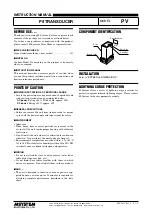
page 45
MARK-V FT-1000MP Operating Manual
O
PERATION
band (for example, tuning from 1.999.99 MHz to
2.000.00 MHz), the higher gain of the “Flat” preamp
will cause the background noise to increase sud-
denly (and decrease again if you tune back inside
the 160-meter band).
(2)When tuning outside of a high-frequency amateur
band (for example, tuning from 28.000.00 MHz to
27.999.99 MHz), the higher gain of the Tuned
premap will cause the background noise to de-
crease suddenly (and increase again if you tune
back inside the 10-meter band).
(3)When operating on the 14 MHz band, the Tuned
and Flat preamps have basically identical gains.
Very little difference in performance will be observed,
inside or outside the 20-meter band.
IPO (Intercept Point Optimization)
Normally, the front-end FET RF amplifiers
provide maximum sensitivity for weak signals. During
typical conditions on lower frequencies (such as strong
overloading from signals on adjacent frequencies), the
RF amplifiers can be bypassed by pressing the [IPO]
button so the green LED is on. This improves the dy-
namic range and IMD (intermodulation distortion) char-
acteristics of the receiver, at a slight reduction of sen-
sitivity. On frequencies below about 10 MHz, you gen-
erally will want to keep the [IPO] button engaged, as
the preamplifiers are usually not needed at these fre-
quencies.
ATT (RF Attenuator)
Even with the IPO function on, ex-
tremely strong local signals can still de-
grade reception. So if you still notice the
effects of overloading, or if the signals
you want to listen to are very strong, you
can use the ATT selector to insert 6, 12, or 18-dB of
RF attenuation in front of the RF amplifier. If background
noise causes the S-meter to deflect on clear channels,
turn the ATT selector clockwise until the S-meter drops
to about S-1 (the white area at the left end of the top
meter scale). This setting optimizes the trade-off be-
tween sensitivity and interference immunity. Also, once
you have tuned in a station you want to work, you may
want to reduce sensitivity further (or add more attenu-
ation) by turning the ATT control to a more clockwise
setting. This reduces the strength of all signals (and
noise) and can make reception more comfortable, im-
portant especially during long QSOs.
When looking for weak signals on a quiet band you
will want maximum sensitivity, so the IPO should be
disabled and the ATT selector should be set to “0.”
This situation is typical during quiet times on frequen-
cies above 21 MHz, and when using a small or nega-
tive-gain receiving antenna on other bands.
D
EALING
WITH
I
NTERFERENCE
AGC (A
UTOMATIC
G
AIN
C
ONTROL
) S
ELECTION
When tuning around the band look-
ing for signals, the AGC selector is usu-
ally best kept in the “AUTO” position,
where AGC decay is automatically se-
lected according to the operating
mode. You can manually select re-
ceiver AGC; however, a few points about AGC and re-
ceiver recovery time need to be pointed out.
For SSB reception
, the “FAST” position allows the
receiver gain to recover quickly after tuning past strong
signals or when fast fading occurs. However, once you
have a station tuned in, reception will usually be more
comfortable if you switch to the “SLOW” position (keep-
ing the receiver from picking up low-level noise during
pauses in speech).
For CW reception
, when several signals are
present in the passband, the “FAST” position can avoid
AGC “pumping” (gain fluctuations) caused by strong
undesired signals.
For AM reception
, the “SLOW” position is usually
better, and for
300-baud packet
and
RTTY/AMTOR
,
the “FAST” or “OFF” positions will usually give the few-
est errors/retries.
RF G
AIN
S
ETTING
When tuned to a moderate strength signal, if low
level background noise is still present after setting the
ATT selector, try reducing the RF GAIN control from
the fully clockwise position. This reduces the signal
input to the first mixer via a PIN diode attenuator and
causes the minimum S-meter reading to move up he
scale, often clearing up the background noise and put-
ting the desired signal more “in the clear.” Remember,
however, to return this control fully clockwise when you
want to receive weak signals, or read low levels on the
S-meter. Also read the box on this page.
Note on AGC
The AGC “OFF” position disables the overload-pro-
tection normally provided by the AGC circuitry. If
the RF GAIN control is left fully clockwise in this
condition, the RF and IF amplifiers can be easily
overloaded (causing distortion) when a strong sig-
nal is received. Correct the overload either by set-
ting the AGC selector to another position, or by
turning the RF GAIN control counterclockwise to
set receiver gain to a comfortable level.
















































